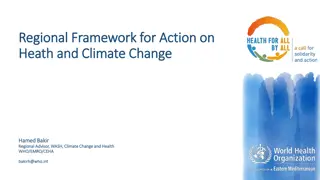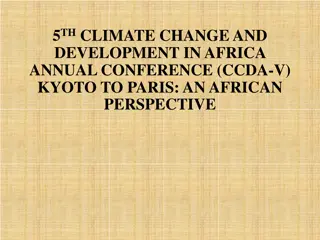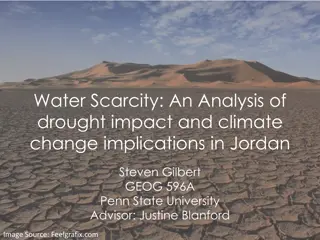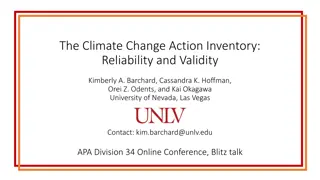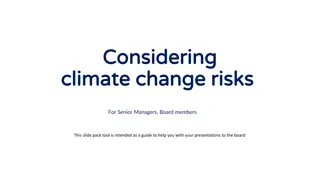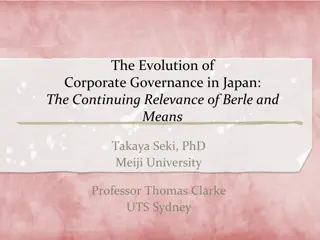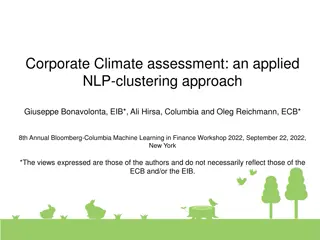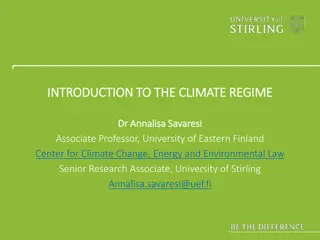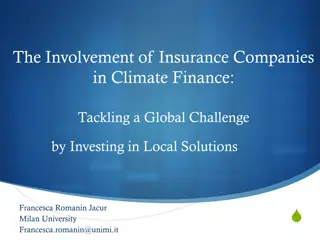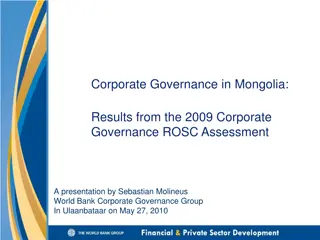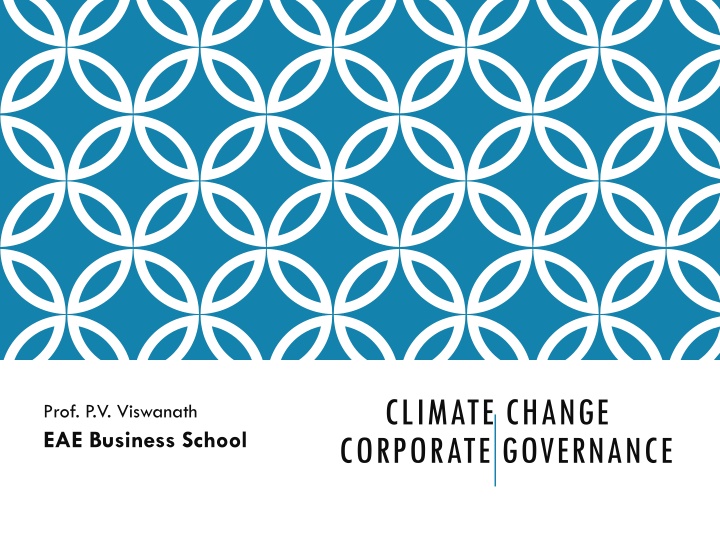
Climate Change and Corporate Governance Insights
Earth's climate has undergone significant changes throughout history, with the current warming trend attributed to human activities. The extent of warming, temperature changes since 1000 CE, and recent global average temperature changes all point to the urgent need for addressing climate change through effective corporate governance strategies. Understanding the geohistorical background is crucial in navigating the complexities of this pressing issue.
Download Presentation

Please find below an Image/Link to download the presentation.
The content on the website is provided AS IS for your information and personal use only. It may not be sold, licensed, or shared on other websites without obtaining consent from the author. If you encounter any issues during the download, it is possible that the publisher has removed the file from their server.
You are allowed to download the files provided on this website for personal or commercial use, subject to the condition that they are used lawfully. All files are the property of their respective owners.
The content on the website is provided AS IS for your information and personal use only. It may not be sold, licensed, or shared on other websites without obtaining consent from the author.
E N D
Presentation Transcript
CLIMATE CHANGE CORPORATE GOVERNANCE Prof. P.V. Viswanath EAE Business School
DISCUSSION The background of climate change Amitava Ghosh and The Great Derangement Climate Change and Corporate Governance Alternatives to Corporate Governance
GEOHISTORICAL BACKGROUND Earth's climate has changed throughout history. Just in the last 650,000 years there have been seven cycles of glacial advance and retreat, with the abrupt end of the last ice age about 11,700 years ago marking the beginning of the modern climate era and of human civilization. Most of these climate changes are attributed to very small variations in Earth s orbit that change the amount of solar energy our planet receives. The current warming trend is of particular significance because it is unequivocally the result of human activity since the mid-20th century and proceeding at a rate that is unprecedented over millennia. Earth-orbiting satellites and other technological advances have enabled scientists to see the big picture, collecting many different types of information about our planet and its climate on a global scale. This body of data, collected over many years, reveals the signals of a changing climate.
EXTENT OF WARMING The planet's average surface temperature has risen about 2.12 degrees Fahrenheit since the late 19th century, a change driven largely by increased carbon dioxide emissions into the atmosphere and other human activities. Most of the warming occurred in the past 40 years, with the seven most recent years being the warmest. The years 2016 and 2020 are tied for the warmest year on record. The ocean has absorbed much of this increased heat, with the top 100 meters (about 328 feet) of ocean showing warming of more than 0.6 degrees Fahrenheit (0.33 degrees Celsius) since 1969. The earth stores 90% of the extra energy in the ocean. The Greenland and Antarctic ice sheets have decreased in mass. Data from NASA's Gravity Recovery and Climate Experiment show Greenland lost an average of 279 billion tons of ice per year between 1993 and 2019, while Antarctica lost about 148 billion tons of ice per year. Global sea levels rose about 8 inches (20 centimeters) in the last century. The rate in the last two decades, however, is nearly double that of the last century and accelerating slightly every year
TEMPERATURE CHANGES SINCE 1000 CE Temperature increases are more likely than decreases, compared to average temperatures from 1000 CE to the present. Note that this graph does not show a secular temperature decline until 1900 CE; the dotted horizontal line is simply the average, which indicates a sharp acceleration since 1900 CE.
GREENHOUSE GASES AND PLANET WARMING The heat-trapping nature of carbon dioxide and other gases was demonstrated in the mid-19th century. Increased levels of greenhouse gases (heat-trapping) cause the Earth to warm in response. Ice cores drawn from Greenland, Antarctica, and tropical mountain glaciers show that the Earth s climate responds to changes in greenhouse gas levels. Ancient evidence can also be found in tree rings, ocean sediments, coral reefs, and layers of sedimentary rocks. This ancient, or paleoclimate, evidence reveals that current warming is occurring roughly ten times faster than the average rate of ice-age-recovery warming. Carbon dioxide from human activity is increasing more than 250 times faster than it did from natural sources after the last Ice Age.
GREENHOUSE GASES AND PLANET WARMING The planet s temperature is basically a function of the energy the Earth absorbs from the sun (which heats it up) and the energy Earth emits to space as infrared radiation (which cools it down). Because of their molecular structure, greenhouse gases temporarily absorb some of that outgoing infrared radiation and then re-emit it in all directions, sending some of that energy back toward the surface and heating the planet. Greenhouse gas concentrations have varied naturally in the past. Over millions of years, atmospheric CO2 levels have changed depending on how much of the gas volcanoes belched into the air and how much got removed through geologic processes. On time scales of hundreds to thousands of years, concentrations have changed as carbon has cycled between the ocean, soil and air. Today, however, CO2 levels have been increasing at an unprecedented pace by taking ancient carbon from geologic deposits of fossil fuels and putting it into the atmosphere when we burn them. Since 1750, carbon dioxide concentrations have increased by almost 50 percent. Methane and nitrous oxide, other important anthropogenic greenhouse gases that are released mainly by agricultural activities, have also spiked over the last 250 years.
WORLD OIL CONSUMPTION Oil consumption 60000 50000 40000 30000 20000 10000 0 In terawatt-hours; source: https://ourworldindata.org/energy- production-consumption. After OPEC cut output and raised prices, consumption dropped until 1980 and then continued rising, probably because of alternate non-OPEC sources of oil.
THE IMPACT OF OPEC ON EMISSIONS One might ask how temperatures could have started rising around 1980? OPEC in 1973 restricted output and raised prices. This must have had the effect of reducing emissions and should have moderated the temperature relative to pre-1973 levels. The answer is that demand for oil is sufficiently inelastic that even though OPEC restricted output and prices rose, users obtained oil from other sources. Hence the impact on oil use was less the OPEC production cut. Furthermore, the oil that substituted for the OPEC oil was of lower quality and produced more emissions than the lighter OPEC oil. Furthermore, world oil consumption, and certainly world GDP seems to have increased year-by-year notwithstanding the increase in oil prices.
IMPACT OF THE PLANETS WARMING There is a difference between weather and climate. Weather is the constantly changing set of meteorological conditions that we experience when we step outside, whereas climate is the long-term average of those conditions, usually calculated over a 30-year period. Although 2 degrees Fahrenheit doesn t represent a big change in the weather, it s a huge change in climate. It s enough to melt ice and raise sea levels, to shift rainfall patterns around the world and to reorganize ecosystems, sending animals scurrying toward cooler habitats and killing trees by the millions. This 2 degree change is an average. However, land areas have warmed about twice as much as the sea surface. And the Arctic has warmed by about 5 degrees. That s because the loss of snow and ice at high latitudes allows the ground to absorb more energy, causing additional heating on top of greenhouse warming. Ice is more reflective and less absorbent of sunlight than land or the surface of an ocean. When ice melts, it typically reveals darker areas of land or sea, and this results in increased sunlight absorption and associated warming.
IMPACT OF CLIMATE CHANGE Agriculture and fisheries are highly dependent on the climate. Increases in temperature and CO2 can increase some crop yields in some places, but could affect yields adversely in others depending upon crop needs. Changes in the frequency and severity of droughts and floods could pose challenges for farmers and ranchers and threaten food safety. Warmer water temperatures are likely to cause the habitat ranges of many fish and shellfish species to shift, which could disrupt ecosystems. Overall, climate change could make it more difficult to grow crops, raise animals, and catch fish in the same ways and same places as we have done in the past. Heat waves, which are projected to increase under climate change, could directly threaten livestock. Drought may threaten pasture and feed supplies. Because of climate change, tidal flooding happens more often, extreme storm events increase, the water table rises, and aquifers get saltier. https://climatechange.chicago.gov/climate-impacts/climate-impacts-agriculture-and-food- supply https://www.epa.gov/cre/climate-change-coastal-communities
CLIMATE CHANGE HITS CLOSE TO HOME WSJ, Nov. 5, 2022 GARDI SUGDUB, Panama From this tiny, hot and overcrowded island, some 1,200 indigenous Guna people will soon embark on a short but historic exodus. Next year, most inhabitants of Gardi Sugdub the name means Crab Island will leave the cluster of thatched and tin-roofed houses traversed by narrow footpaths where they have lived for more than a century, and head for the Panamanian mainland about a mile away. These indigenous people will become the first residents in Latin America to be moved pre- emptively by their government from an island whose fate scientists say is to be swallowed by the sea in coming decades due to rising tides caused by climate change. PV Viswanath on one of the San Blas Islands belonging to the Guna in 2016
IMPACT ON THE US ECONOMY The effects of climate change will not be shared evenly across the United States; places that are already struggling will tend to be hit the hardest. The South will be harder hit, as will low-income communities because of greater exposure and vulnerability; this implies a disproportionate impact on minority communities. Black, Latino, and indigenous communities are likely to bear a disproportionate share of climate change burden (Gamble and Balbus 2016).
Some places are much more exposed to economic damages from climate change than are other places; the same increase in atmospheric carbon concentration will cause larger per capita damages in India than in Iceland.
PARIS CLIMATE AGREEMENT The number of record high temperature events in the United States has been increasing, while the number of record low temperature events has been decreasing, since 1950. The U.S. has also witnessed increasing numbers of intense rainfall events. Climate Change is an example of the Prisoner s Dilemma, where each agent (country) acting rationally can reduce welfare for the group (the world). Hence the need for cooperation. Under the Paris Climate Agreement, which President Biden recently rejoined (in January 2021), countries have agreed to try to limit total warming to between 1.5 and 2 degrees Celsius, or 2.7 and 3.6 degrees Fahrenheit, compared to preindustrial times.
NEGATIVE EXTERNALITIES When private decision makers cause harm to an unrelated third party, that harm is called a negative externality. For example, if a power plant generates electricity and sells it to its customers, the pollution it emits in the process may affect the health of neighboring communities. The health effects of this pollution would be a negative externality of the power plant s electricity generation and sale. Arthur Pigou s seminal 1920 book, The Economics of Welfare, introduced the idea of taxing negative externalities. In his book, Pigou showed that taxing a negative externality at a price equal to the marginal damage internalizes the externality and maximizes overall welfare.
ALTERNATIVES TO CARBON-BASED FUELS Alternatives to carbon-based fuels are becoming more affordable. However, the costs of global warming are borne by everybody and not only by direct consumers of carbon-generating activity. Hence we need measures to allow these costs to be internalized and included in the price of carbon.
ALTERNATIVE APPROACHES TO EMISSIONS ABATEMENT There are many ways to reduce net carbon emissions, from better livestock management to renewable fuel subsidies to reforestation. Each of these abatement strategies comes with its own costs and benefits. One approach is to impose emissions standards. The problem is that government regulators have limited information about abatement costs or political pressures that favor some standards over others. The Clean Power Plan a since-discontinued 2014 plan required reductions in power sector emissions as well as methane flaring regulations and reforestation. This is a stick approach. A more of a carrot approach is taken by weatherization assistance plans and the vehicle trade-in policy Cash for Clunkers, which are more expensive than the Clean Power Plan. Carbon prices use the market mechanism. A carbon price helps to achieve a given emissions reduction target at the minimum cost by encouraging abatement actions that cost less than the carbon price and discouraging actions that cost more than that price.
CARBON PRICING Carbon pricing is a climate policy approach used in a number of countries and subnational jurisdictions (regions, states, provinces, cities) around the world. Carbon pricing works by charging emitters for the tons of emissions of carbon dioxide (CO2) for which they are responsible. CO2 is emitted largely through the combustion of fossil fuels used for electricity generation, industrial production, transportation, and use of energy in residential and commercial buildings. Carbon pricing policies can take two forms: carbon taxes and cap-and-trade programs. A carbon tax is a price set per ton of carbon or, more commonly, per ton of CO2 emitted. Because CO2 emissions from the combustion of fossil fuels are proportional to the carbon content of the fuel, a carbon tax is, in effect, a tax on CO2. A $1 tax per ton of CO2 is equal to a $3.7 tax per ton of carbon, because carbon constitutes roughly 3/11 of the weight of CO2.
CAP-AND-TRADE PROGRAMS A cap-and-trade program limits the total amount of CO2 that can be emitted by certain facilities. In a cap-and-trade program, the government issues a limited number of emissions allowances (also known as permits), each of which grants the holder the right to emit one ton of CO2. Allowances can be distributed in a number of ways: they can be directly allocated to firms or facilities (a concept called free allocation of allowances) or sold through auction markets. The limited, government-controlled supply of allowances caps the total amount of emissions. Allowances can be traded, and the sales and purchases (supply and demand) of allowances yield a market price for allowances essentially the price of one ton of CO2 emissions.
BANKING AND BORROWING OF ALLOWANCES Some cap-and-trade programs include provisions for the banking and borrowing of allowances over time: permits issued in one year can be submitted to account for emissions in later years (banking), and permits for future years can be issued and used in the current year (borrowing). When banking and borrowing take place, emissions during a specific year may be greater or less than the number of allowances issued in that year, but over time, the emissions and allowances are balanced. Banking and borrowing gives firms more flexibility in methods of compliance and reduce the costs of meeting a cumulative emissions target.
EFFECT ON ECONOMIC UNCERTAINTY Carbon taxes and cap-and-trade programs primarily differ by the type of certainty they provide. Carbon taxes provide price certainty, as entities subject to the tax know how much they ll have to pay per ton emitted but simply setting a tax rate doesn t guarantee any particular level of emissions reductions. Cap-and-trade programs, on the other hand, set a cap on emissions and therefore provide quantity certainty but price fluctuations under the trading market structure can provide a less solid basis for business planning decisions. Hybrid systems, however, can be used to reduce price or emissions uncertainty. Under cap-and-trade programs, price floors and ceilings have been proposed and utilized to prevent prices from being too low or too high. Carbon taxes can also be designed to automatically adjust if actual emissions miss some predetermined emissions path.
ADVANTAGES OF CARBON PRICING RELATIVE TO MANDATES Flexibility Carbon pricing allows firms to choose the most efficient method to reduce (or not to reduce) emissions in response to the carbon price. Under other policies, such as technology mandates, a regulator chooses a single method for a wide set of firms. Such one-size-fits-all approaches may lead to unnecessarily costly reductions for some firms if cheaper methods to reduce emissions exist. Equal Marginal Costs of Abatement An economy-wide carbon price applies a uniform price on CO2 emissions regardless of the source. As a result, the marginal abatement costs (the costs to firms of decreasing their emissions by one unit) are equalized across firms and sectors. This is a necessary condition for minimizing the overall costs of emissions reductions.
ADVANTAGES OF CARBON PRICING: ENCOURAGING CONSERVATION A carbon price encourages individuals and businesses to reduce their carbon emissions more than conventional regulations. A conventional regulation (such as a performance standard) sets a strict limit on emissions per unit of output, but does not provide incentives to reduce overall demand. In contrast, carbon pricing provides incentives to reduce emissions per unit of output, but also charges a price for every additional ton of CO2 that is not reduced through increased efficiency. Therefore, the price of carbon-intensive goods (i.e., electricity or gasoline) will likely be higher under a carbon price than under conventional regulations, which encourages individuals and businesses to reduce their demand (to the extent possible). Thus, a carbon price encourages more conservation than conventional regulations.
CARBON ABATEMENT PROGRAM OPTIONS Price: According to economic theory, emissions pricing produces the highest net benefits (environmental, health, and other benefits minus economic costs) when the carbon price is equal to the marginal damage of carbon emissions, or the damage caused by adding one additional ton of carbon dioxide into the atmosphere. This would be accomplished either by setting the carbon tax equal to the marginal damage or, under a cap-and-trade program, by capping emissions at a level that leads to an emissions allowance price equal to the marginal damage. Policy stringency is determined by the level of the tax rate (under a carbon tax) or the level of the emissions cap (under cap and trade) and how they change over time. A $50 carbon tax is more stringent than a $10 carbon tax: it will lead to lower emissions and higher costs. The coverage of a carbon pricing policy determines which sectors of the economy and which emission types are covered by the carbon price. For example, the European Union Emissions Trading System cap-and-trade program covers CO2, nitrous oxide (N2O), and perfluorocarbons (PFCs). Special considerations provided to some firms in order to avoid carbon leakage, i.e. transfer of production by firms to other countries with laxer emissions constraints, because of costs related to climate policies.
CARBON ABATEMENT PROGRAM OPTIONS The point of regulation of a carbon price determines exactly who is required to submit permits or pay the tax to the government. An upstream carbon tax would tax fossil fuel producers for the carbon content (and hence ultimate CO2 emissions) of their products. A midstream tax would tax the first purchaser of fossil fuels in the supply chain. For example, a midstream tax would require a refinery to pay for the carbon content of all the crude oil it purchases. A downstream tax applies to the final consumer: for example, coal-fired generators, industrial users, or households and businesses that use gasoline in their vehicles or natural gas in their homes and businesses. With the exception of cap-and-trade programs that freely allocate allowances to firms, carbon pricing policies raise revenue. Both the overall economic costs and the distribution of those costs across segments of society are significantly determined by how the revenues are used.
REVENUE USE OPTIONS A carbon dividend distributes the revenue from a carbon price back to households, typically in the form of a check, a tax credit (annually or through adjustments to employer tax withholding), supplements to existing payments from federally administered benefit programs like Social Security, or through payments using the electronic benefit transfer system (used to deliver food stamp benefits). A carbon dividend may be, but does not need to be divided in equal amounts (it can be divided based on one s income, tax returns, or other factors), and the details of a carbon dividend vary among policies. Carbon dividends will likely be progressive, as the dollar amount of a carbon dividend will likely exceed the increased costs incurred by the average low- and middle-income household. Revenue can also be used for tax-swaps to reduce distortionary effects of carbon pricing. For example, payroll taxes could be decreased in order to reduce the impact on employment. Revenue can be used to finance green spending programs, such as subsidies for electric vehicles or clean energy generation, fund weatherization programs, investment in energy efficiency improvements. However, these have been found to be regressive in the past.
IMPACT ON WORKERS IN COAL-RELATED INDUSTRIES Although carbon taxes and cap-and-trade systems might increase GDP and be Pareto-optimal, they might not be beneficial to all segments of the economy. For example, there are likely to be job losses at fossil-fuel power plants. These may be replaced by new jobs in non- polluting industries, such as renewable energy plants or service industries, so that there may be no net job loss. However, the new jobs may be in different parts of the country (or the world) and may require different skills. A firm that loses jobs in response to a carbon price may do so in two ways. The firm can lay off or discharge workers, or it can reduce (or stop) the hiring of new workers and allow for natural attrition in its workforce. Layoffs tend to affect workers who have worked in a sector for years. These effects can be persistent and can affect low-income workers more.
DOES THE MARKET TAKE CARBON PRICING SERIOUSLY? The physical risks from climate events and the transition risks from a tightening of environmental regulations, can affect the value of financial assets. The more informed investors and creditors are of the financial risks of climate change, the more they will reallocate from investments with high climate-related financial risks to more environmentally beneficial investments with lower risks. Firms with relatively high emissions are at a greater risk of suffering financial penalties if environmental policies tighten. Direct penalties can result, for instance, from the extra costs of carbon taxes on firm emissions. These can apply to firms in all industries with a carbon footprint and are not limited to fossil fuel producers. Ehlers, Packer and de Greiff (2021) find a significant carbon premium since the Paris Agreement in the pricing of syndicated loans to firms. However, the price of risk appears to be relatively low given the material risks faced by borrowers. Also, only carbon emissions directly caused by the firm are priced, and not the overall carbon footprint including indirect emissions.
CROSS-BORDER EFFECTS OF CARBON PRICING Since the impact of carbon pollution does not stop at borders, it is important to consider carbon policies on a global scale. This is the reason for the Paris accords, which brings many different governments together to address climate issues. Carbon pricing can affect the profitability of certain sectors of the economy and reduce the flow of credit to those sectors. However, the integrated nature of the financial system can lead to unexpected effects. Researchers at the European Central Bank analyzed data on more than 2m loan tranches involving banks doing cross-border lending between 1988 and 2021 and found that carbon taxes at home led banks to reduce lending to coal, oil and gas companies domestically, but also had the perverse consequence of increasing lending to countries lacking a carbon tax.
SOCIAL COST VERSUS MARKET COST The Biden administration has been using the Interagency Working Group s interim value of $51 per metric ton of CO2. Earlier this month, EPA proposed increasing that number to $190, based on recent research. These prices are from November 28th, 2022
CHAPTER 1 There is an excessive focus on humans and the plight of humans to the exclusion of things and animals. In fact, the emphasis has been on overcoming the limitations imposed by nature nature has been the enemy. We have seen this in the drive to use waterpower through the construction of dams for hydroelectric power and levees to enable agriculture along the banks of river and seawalls to allow residences close to the coast and preventing the burning of forests to, again, allow unrestricted access of human beings to these forests. In each of these cases, nature has come back with a vengeance. Even though we now know the problems with these approaches, the impetus of growth prevents us from taking the right actions. Art and fiction, too, has turned against the external world into thinking and exploring the internal mind. There is a positive correlation between the use of carbon fuels and the political engagement of writers and artists. Writers and artists are obsessed with being in the vanguard; but the notion of the vanguard means that there is always forward movement, progress. Revolutionary ruptures, each of which renders its predecessor obsolete. This is consistent with the capitalist obsession with growth. Even the third world has felt the pressure to keep up with the Western, Anglophone world to be more modern, which means to consume more. Ghosh claims that only a few writers Barbara Kingsolver, Doris Lessing, Cormac McCarthy, Ian McEwan, J.G. Ballard, Margaret Atwood, Kurt Vonnegut Jr. and T. Coraghessan Boyle have written about climate change.
CHAPTER 2 Political engagement by intellectuals has been similar to that of artists. The focus has come to be on the moral, as the expression of authentic experience, the depiction of what is felt. However, it is not necessary to restrict the domain of fiction to what is, but rather it can be extended to what might be. Intellegentsia, artists and the public alike find it difficult to relate to things, to phenomena, as opposed to people. Proof in point one can ask where were you on 9/11? But one cannot ask where were you when the Larsen B ice shelf broke up ? But more than that, there is the feeling that one s opinions, even when made manifested through demonstrations will not affect what actually happens. Power is exercised by the interlocking complex of corporations and institutions of governance that has come to be known as the deep state. This sense of helplessness is behind the support for Jeremy Corbyn (the erstwhile Labor leader in the UK), Bernie Sanders and even Donald Trump.
CHAPTER 3 Matters are seen in terms of issues of conscience privately felt emotions. However climate change is a public phenomenon; people acting individually will not be able to affect it because it is a commons problem. The basis of neoclassical economics is that individuals acting in their own self-interest are able to produce outcomes that are good for everybody. This may be true in many cases, but not when we have externalities, as in the case of climate change. Keynes quote on this issue on p. 134. This individualistic idea also characterizes the popular religion on the right in the United States and in many other countries it has a millenarian character with individualism, free trade and God constituting parts of a whole. But even secular paradigms, such as John Rawls s theory of justice, are founded upon assumptions about individual rationality, borrowed from neo-classical economics.
CHAPTER 4 Unfortunately, the ideas of the Anglosphere affect many parts of the world today. Climate deniers can be found in greatest numbers in the US; but climate scientists can also be found in the US. Identity and performativity are now central to public discourse, and climate change too has become enmeshed with the politics of self-identity. Part of this is because of the impact of the media controlled by people like Rupert Murdoch, who give a voice to climate deniers. However, the security establishment at the same time that it is monitoring climate activists for subversive activities is cognizant of the threat of climate change and is taking steps to protect itself against it.
CHAPTER 5 Although considerations of justice are paramount in the question of climate change because the current situation is mostly due to the use of carbon fuels by the West in the past. However, the political establishment is driven mainly by considerations of security in its attitude towards the exterior. Hence it is not voluntarily going to support a reduction in the use of fossil fuels, especially if there is not such a reduction by countries like India and China. This leads to a politics of the armed lifeboat. According to this, countries like the US have no intention of changing the status quo, but at the same time, they will make sure that they are not affected by climate change to whatever extent possible. Most of the effects are likely to be felt by the Third World including the many island nations. We see this in the attitude of Western countries towards immigrants, who are displaced because of previous actions by the West, yet the West is not willing to accept responsibility for its actions.
CHAPTERS 6 & 7 This issue of national security in conjunction with capitalism is driving us inexorably towards a climate catastrophe. Balanced with the politics of the armed lifeboat is the politics of attrition that might be played by developing countries. They are much better able to bear climate extremes than people in the US. Previously in the book, Ghosh showed how the empires, such as Great Britain prevented the development of industry in the colonies, which has led to the current imbalance in accumulated riches.
CHAPTERS 8 AND 9 Ghosh contrasts the Pope s encyclical with the 2015 Paris Agreement and shows that the latter systematically excludes the possibility of any notion of climate justice. Furthermore, it relies on technological advances rather on an acknowledgement of the commons problem inherent in climate change. It is very technically oriented, whereas the Pope calls for an openness to categories which transcend the language of mathematics and biology and take us to the heart of what it is to be human. The Paris Agreement is squarely based upon the neo-classical foundations of economics. He ends with a message of hope, noting that different (non- protestant) religions have started to weigh in on the question of climate change, thus hopefully looking towards a possible non- neoclassical solution to the problem, one that recognizes its group character rather than rely on individualistic solutions.
A ROLE FOR CORPORATE GOVERNANCE Are there not other common resource problems in the world? Is climate change so different? What about pollution? What about the overconsumption of raw materials and minerals that was supposed to overwhelm the world according to the Rome accords? https://www.economist.com/christmas- specials/1997/12/18/plenty-of-gloom
THE ARMED LIFEBOAT SCENARIO Does the West have a vested interest in the status quo? Are we going towards the armed lifeboat solution?
IS CAPITALISM THE PROBLEM? Is there an inherent problem with corporations acting against their own self-interest in a capitalistic world? If the problem cannot be resolved at the domestic level, how can it be resolved at the international level? Keep in mind that regulation can only be instituted and implemented when there is a political will, but which political solutions are chosen is itself impacted by corporate power.
VIOLENCE, B-CORPORATIONS AND LITERATURE What is the likelihood of developing nations snatching their rights violently? What about B-corporations? Is there a role for literature and religion?




